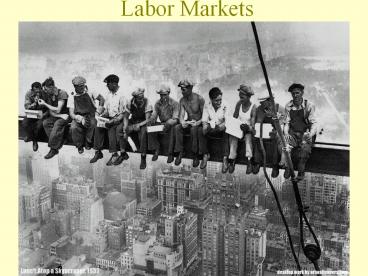Labor%20Markets PowerPoint PPT Presentation
Title: Labor%20Markets
1
Labor Markets
2
What do you think is the Federal hourly minimum
wage?
- 3.75
- 4.85
- 5.25
- 5.85
- 6.00
- 6.85
- 7.00
- 8.00
- 9.00
3
What do you think is the Federal hourly minimum
wage?
- 3.75
- 4.85
- 5.25
- 5.85
- 6.00
- 6.85
- 7.00
- 8.00
- 9.00
4
Minimum wage
- The minimum wage is now 5.85. By recent
legislation, it will rise to 6.55 in mid 2008
and to 7.25 in mid 2009.
5
History of U.S. minimum wage
6
State Minimum wages
- California 7.50, will be 8.00 in 2008.
- Massachusetts 7.50
- New York 7.15
- Oregon 7.80
- Washington 7.93
- Illinois 7.50
- Michigan 7.15
7
Not covered by min wage law
- Agricultural workers
- Workers under 20 years of age
- Small business employees (under 500,000 gross)
8
What was your hourly wage in your most recent job?
- More than 15
- 10-15
- 6-10
- 5-6
- Less than 5
- I ve never had a wage job.
- I dont remember.
9
A minimum wage rate is set 20 higher than the
equilibrium wage. This causes total wages
received by laborers to rise only if
- Labor supply is elastic.
- Labor supply is inelastic.
- Labor demand is elastic.
- Labor demand is inelastic.
- Employers are irrational.
10
Why is that?
- Minimum wage moves quantity to a point on which
curve? Demand or supply? - On the DEMAND curve. Firms are not forced to hire
more labor than they want. - If you move up the demand curve and revenue
rises, is demand elastic or inelastic? - Inelastic.
11
Min wage diagram
Price
Min wage
Old wage
Quantity
12
If a price floor is set on some good at a price
higher than its equilibrium price,
- A) The good will be in excess supply.
- B) The good will be in excess demand.
- C) Neither prices nor quantities will be
affected.
13
Price floor above equilibrium
Price
Price floor
Original Equilibrium
Quantity
14
If a price floor is set on some good at a price
lower than its equilibrium price,
- The good will be in excess supply.
- The good will be in excess demand.
- Neither prices nor quantities will change.
15
And why is that?
- Price floor says it is illegal to sell at a price
below the specified floor. - If floor is below equilibrium price, the
equilibrium price satisfies this restriction. - The restriction is non-binding and doesnt affect
outcome.
16
Equilibrium Above the Price floor
Price
Original Equilibrium
Price floor
Quantity
17
And back to our lecture
Leave your Clicker on, Well be clicking again
later
18
The supply curve slopes up. The demand curve
slopes down. If a price ceiling is set at a
price lower than the equilibrium price, what
happens to the price and the quantity sold?
- Price and quantity both fall.
- Price falls, quantity rises.
- Neither changes.
- Price rises, quantity falls.
- Price falls, quantity rises.
19
Why is that?
20
The supply curve slopes up. The demand curve
slopes down. If a price ceiling is set at a
price higher than the equilibrium price, what
happens to the equilibrium price and quantity?
- Price and quantity both fall.
- Price falls, quantity rises.
- Neither changes
- Price rises, quantity falls.
- Price falls, quantity rises.
21
Why is that?
- If price ceiling is higher than equilibrium
price, it does not forbid equilibrium price.
22
The demand elasticity is 1/2. The supply
elasticity is 1. A price ceiling that is 20
below equilibrium price will cause the new
equilibrium quantity to
- Fall by 20.
- Rise by 10.
- Fall by 10.
- Rise by 20.
- Remain unchanged.
23
Why is this?
- Price ceiling forces price down by 20 and
results in excess demand. - New quantity will be on supply curve. Suppliers
are not forced to sell. - Supply elasticity is 1, so a 20 fall in price
results in a 20 fall in quantity.

